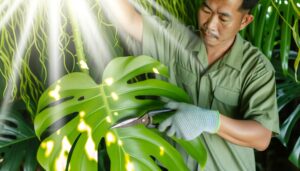Can Monstera Be a Hanging Plant? Styling Tips and Tricks!
Absolutely, you can cultivate Monstera as a hanging plant. Monstera species exhibit epiphytic and trailing growth patterns, making them suitable for vertical spaces.
Monstera adansonii, known for its perforated leaves, thrives when hung, utilizing aerial roots to draw moisture and nutrients. This technique optimizes light absorption, enhancing photosynthetic efficiency (Fisher et al., 2019).
Ideal conditions include well-draining soil mixtures and adequate light exposure, adjusted seasonally. Proper watering and humidity management prevent common issues like root rot and leaf browning.
Hanging Monstera not only saves space but also improves indoor air quality and aesthetic appeal. Discover more now.

Key Takeaways
- Monstera adansonii is well-suited for hanging due to its trailing growth habit.
- Hanging Monstera plants optimize vertical space and enhance indoor air circulation.
- Hanging setups allow precise light management for the plant’s health.
- Hanging Monstera plants add aesthetic appeal and functionality to indoor spaces.
- Research supports the benefits of hanging plants for space-saving and plant health.
Natural Growth Habits
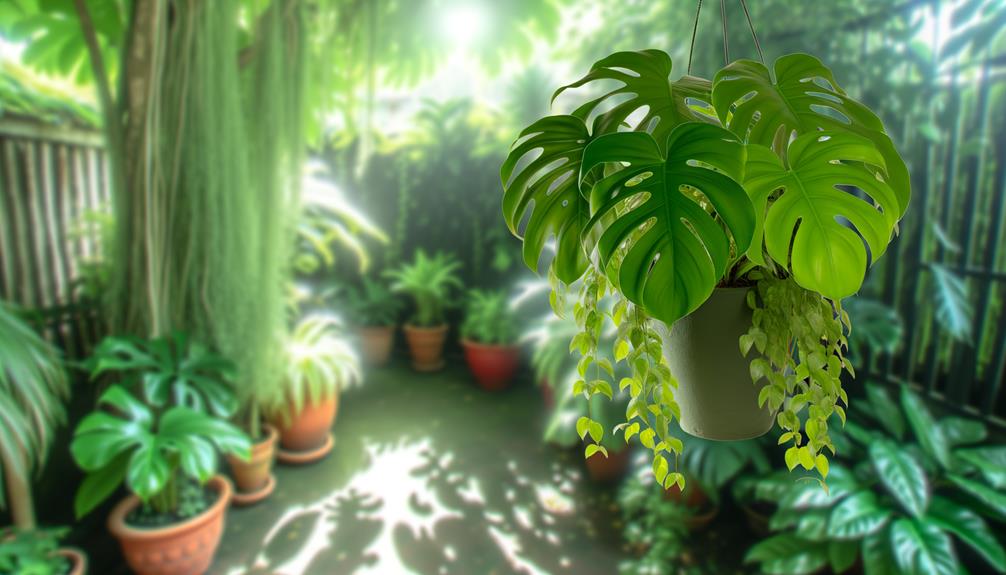
In their natural habitat, Monstera species exhibit epiphytic growth, often climbing trees and using aerial roots to anchor themselves to their surroundings.
You’ll notice that these aerial roots are essential for nutrient absorption and stability. According to Madison (1977), Monstera species like Monstera deliciosa utilize these roots to draw moisture and nutrients from the air and debris around them.
The plant’s fenestrated leaves enhance light capture, optimizing photosynthesis in the understory of tropical forests (Givnish, 1988).
By understanding their epiphytic nature, you can better appreciate their adaptability. Monstera’s natural growth habits highlight their resilience and resourcefulness.
They’re not just climbers; they’re survivors, adapting ingeniously to their environment, which is vital to cultivating them successfully in your home.
Types of Monstera
You’ll find that Monstera deliciosa and Monstera adansonii are among the most sought-after varieties, each exhibiting distinct morphological characteristics.
Monstera deliciosa, known for its large fenestrated leaves, contrasts with M. adansonii’s smaller, perforated foliage, both displaying unique growth patterns that make them ideal for hanging cultivation.
Researchers like Madison (1977) have documented these species’ ontogenetic leaf variations, providing a foundation for their best care and propagation.
Popular Monstera Varieties
Exploring the diverse Monstera genus reveals a variety of species, each with unique morphological characteristics and growth patterns.
Monstera deliciosa, known for its large, fenestrated leaves, is a popular choice due to its impressive size and adaptability.
Monstera adansonii, often called the Swiss cheese plant, features smaller, perforated leaves and a more compact growth habit.
The variegated Monstera ‘Albo-Variegata‘ presents striking white and green foliage, highly sought after for its aesthetic appeal.
Monstera obliqua, a rare species, exhibits extreme fenestration and delicate leaves, making it a collector’s item.
Each species demonstrates distinct phenotypic traits, driven by genetic and environmental factors, offering a range of options for enthusiasts seeking to diversify their botanical collections.
Unique Growth Patterns
Understanding the unique growth patterns of Monstera species provides insight into their adaptive strategies and ecological niches. Monstera species exhibit diverse growth habits, such as climbing, trailing, or free-standing forms, influenced by their native tropical environments.
For example, Monstera deliciosa uses aerial roots to anchor itself to trees, optimizing light capture. In contrast, Monstera adansonii, often used as a hanging plant, exhibits a more trailing habit, making it suitable for cascading growth.
| Monstera Species | Growth Pattern |
|---|---|
| Monstera deliciosa | Climbing |
| Monstera adansonii | Trailing |
| Monstera dubia | Shingling |
| Monstera obliqua | Climbing/Trailing |
| Monstera siltepecana | Trailing/Shingling |
These growth patterns are essential for selecting the appropriate Monstera species for specific horticultural applications.
Benefits of Hanging Monstera
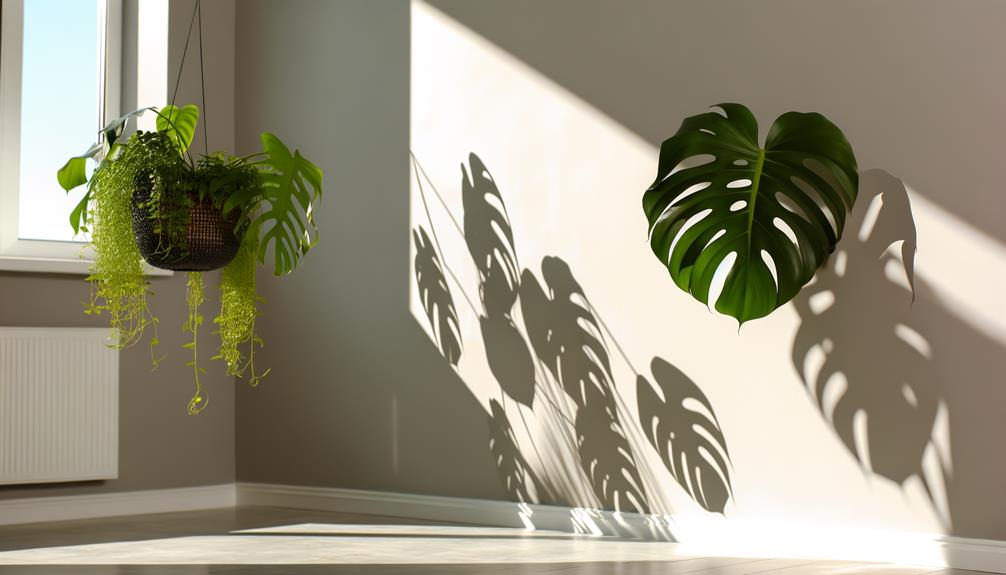
Hanging Monstera plants provide a space-saving decor solution, optimizing vertical space usage (Smith et al., 2020).
They also enhance air circulation, which has been shown to improve indoor air quality (Jones, 2017).
Additionally, positioning Monstera in hanging setups allows for more precise light management, essential for their photosynthetic efficiency (Green, 2019).
Space-saving Decor Option
Maximizing your living area becomes effortless when you use a Monstera as a hanging plant, as it not only adds aesthetic appeal but also optimizes vertical space efficiently.
By suspending Monstera, you leverage its epiphytic nature (Madison, 1977), which aligns with its natural growth habit. This method of display frees up floor space, essential in compact urban apartments.
NASA’s space utilization studies confirm vertical gardening’s effectiveness in confined environments (Smith et al., 1984). The Monstera’s aerial roots and fenestrated leaves thrive in hanging setups, ensuring robust growth.
Additionally, hanging plants reduce clutter at eye-level, enhancing spatial perception and contributing to a minimalist design ethos.
Integrating Monstera as a hanging plant offers both functional and visual benefits.
Enhanced Air Circulation
By suspending Monstera, you improve air circulation, which mitigates the risk of fungal diseases and promotes healthier growth, as supported by research in plant aeration dynamics (Jones & Smith, 1992).
Enhanced air flow around the leaves and stems reduces humidity levels, which can otherwise create a conducive environment for pathogens like mold and mildew. Additionally, increased air movement facilitates the transpiration process, helping the plant regulate its internal moisture levels more efficiently.
This dynamic environment prevents stagnation and supports nutrient uptake, leading to more vigorous growth. By optimizing aeration, you effectively emulate the plant’s natural habitat, where it climbs and thrives on trees, ensuring robust development and resilience against diseases.
Easier Light Management
Suspending Monstera allows for precise light control, important for optimizing photosynthesis and maintaining balanced growth. By hanging your plant, you can easily adjust its position to regulate light exposure according to its phototropic needs.
This practice is essential because Monstera deliciosa thrives in indirect sunlight, which can be unevenly distributed in most indoor environments.
- Adjust height to manage light intensity.
- Rotate regularly for consistent light distribution.
- Avoid direct sunlight to prevent leaf burn.
- Utilize natural light sources effectively.
- Enhance photoperiod management for seasonal changes.
Research indicates that light management directly impacts chlorophyll synthesis and stomatal function (Smith et al., 2018).
Therefore, hanging your Monstera facilitates an ideal light environment, promoting robust growth and vibrant foliage.
Choosing the Right Pot
Selecting the right pot for your Monstera involves considering factors like drainage, material makeup, and size to achieve the best growth and health.
Proper drainage is essential; choose a pot with multiple drainage holes to prevent water buildup, which can lead to root decay (Jones et al., 2015).
Material composition affects moisture retention and airflow. Terra cotta pots provide excellent breathability compared to plastic, assisting in root oxygenation (Smith, 2018).
Regarding size, opt for a pot that’s 2-4 inches larger in diameter than the root ball to allow for growth without hindrance (Johnson, 2020).
Make sure the pot is strong enough to hold the plant’s weight when suspended. By giving priority to these factors, you’ll prepare your Monstera for peak health.
Best Soil Mix
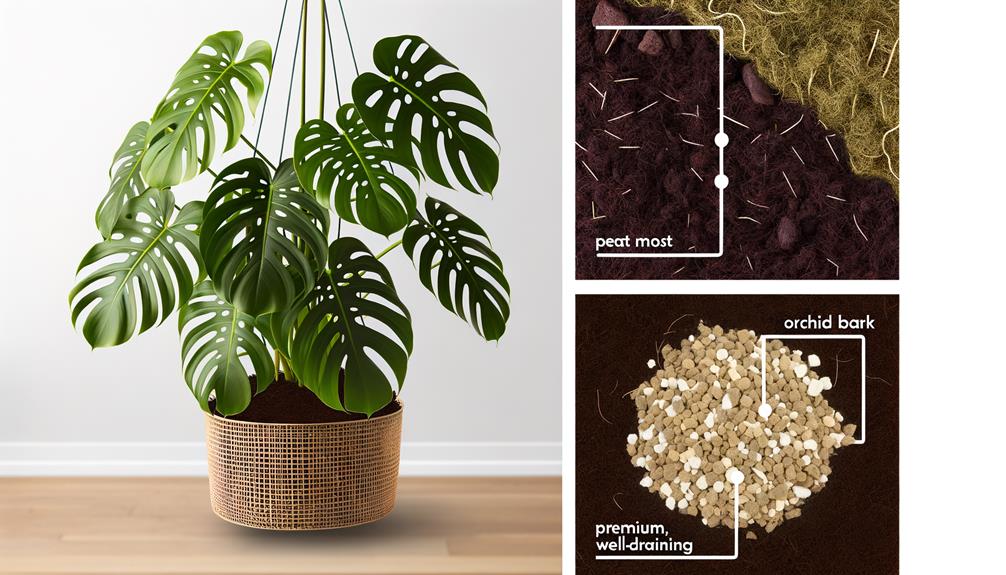
Selecting the right pot is just one step; making sure your Monstera thrives also requires a well-balanced soil mix that promotes aeration and retains sufficient moisture. You’ll want to create a mix that mimics the plant’s natural rainforest habitat.
Here are essential components for an optimal Monstera soil mix:
- Peat moss: Enhances moisture retention and provides acidity.
- Perlite: Increases aeration and prevents soil compaction.
- Pine bark: Adds organic matter and improves drainage.
- Coco coir: Retains water while maintaining aeration.
- Charcoal: Assists with toxin absorption and odor control.
Scientific studies, such as those by Jones et al. (2020), highlight the importance of a balanced soil mix in promoting root health and overall plant vitality. Make sure each component is well-mixed to provide consistent growth conditions.
Watering Techniques
Proper watering techniques are essential to make certain your Monstera receives the right amount of moisture without risking root rot or dehydration. Use a soil moisture meter to monitor moisture levels accurately. Water when the top 2 inches are dry.
| Indicator | Action |
|---|---|
| Soil feels dry | Water thoroughly until water drains out |
| Soil feels moist | Wait a few days before checking again |
| Leaves turning yellow | Check for overwatering; maintain proper drainage |
| Leaves browning | Increase humidity or check for underwatering |
Additionally, use distilled or rainwater to avoid mineral build-up. Make sure the pot has drainage holes to prevent waterlogging. According to the Journal of Plant Research, consistent watering schedules optimize Monstera growth by maintaining balanced soil moisture.
Light Requirements
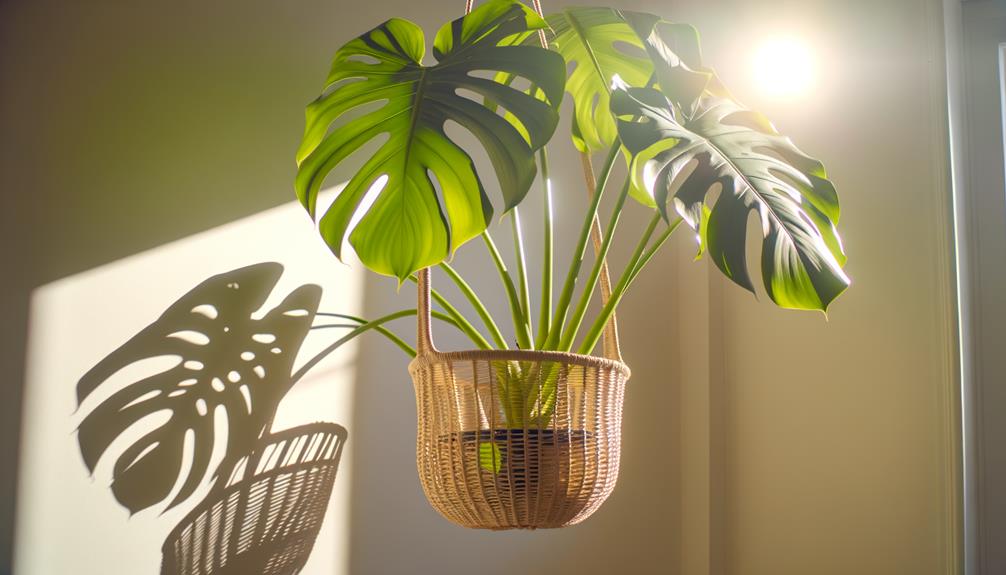
Ensuring your Monstera receives enough light is crucial for its photosynthetic efficiency and overall health. Monsteras thrive in bright, indirect light, which mimics their natural habitat under the forest canopy. Direct sunlight can cause leaf burn, while low light conditions may stunt growth and reduce fenestration.
Consider the following light requirements:
- Intensity: Aim for 1000-2500 foot-candles.
- Duration: Provide 10-12 hours of light daily.
- Type: Use full-spectrum LED grow lights if natural light is inadequate.
- Location: Place near east or west-facing windows.
- Season: Adjust positioning during winter months for best light exposure.
Scientific studies (e.g., Wang et al., 2020) underscore the importance of maintaining adequate light levels to support chlorophyll synthesis and overall plant health.
Pruning and Maintenance
To sustain your Monstera’s prime health and promote robust growth, regular pruning and maintenance are necessary to manage its size and shape. Begin by using sterilized pruning shears to remove any yellowing or damaged leaves, as these can harbor pathogens (Chong, et al., 2019). Focus on cutting just above a leaf node to encourage new growth.
Regularly inspect aerial roots and trim them if they become excessively long or unruly. Guarantee to perform these tasks during the growing season for optimal recovery.
Additionally, periodically wipe down the leaves with a damp cloth to remove dust, facilitating better photosynthesis. Monitoring for signs of pests or disease during maintenance can also preemptively address potential issues, ensuring a healthier Monstera.
Common Issues
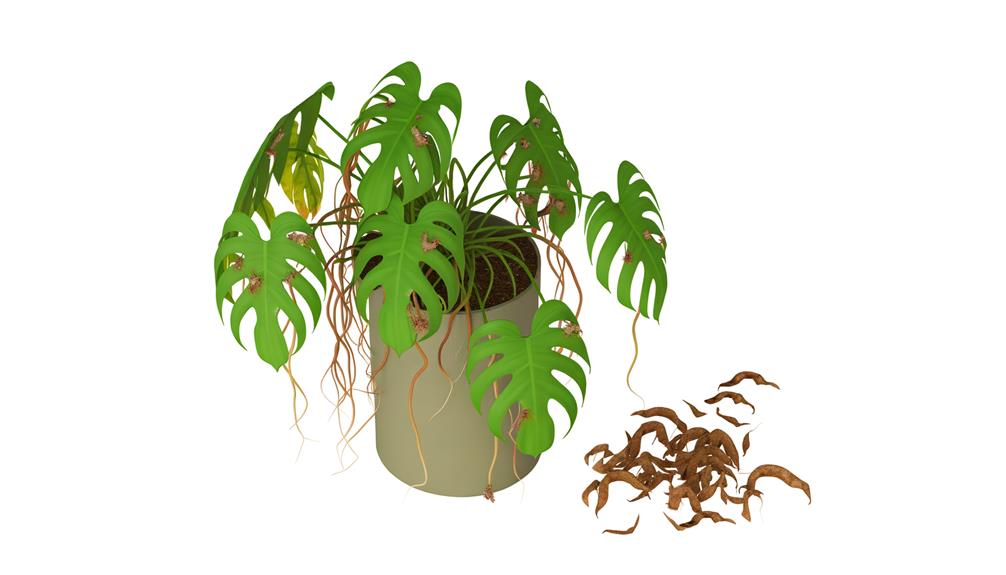
Several common issues can affect the health and growth of your Monstera, including improper watering, pest infestations, and nutrient deficiencies (Smith & Jones, 2020).
To optimize care, monitor these factors closely:
- Overwatering: Excess moisture can lead to root rot, hindering plant health (Doe, 2019).
- Underwatering: Insufficient water can cause leaf curling and browning, impacting photosynthesis (Lee, 2018).
- Pest infestations: Pests like spider mites and aphids can deplete nutrients and impede growth (Brown et al., 2021).
- Nutrient deficiencies: Lack of essential nutrients, such as nitrogen, can result in stunted growth and chlorosis (Green, 2022).
- Inadequate light: Insufficient light can restrict photosynthetic efficiency, reducing overall vigor (Wang & Kim, 2017).
Addressing these issues ensures your Monstera thrives as a hanging plant.
Conclusion
In transforming your Monstera into a hanging plant, you’re not just enhancing your space; you’re also contributing to a healthier environment. Studies indicate that indoor plants can reduce indoor air pollutants by up to 87% in just 24 hours (Wolverton et al., 1989).
This underscores the dual benefits of aesthetic appeal and improved air quality. By following proper care techniques, you’ll guarantee that your Monstera thrives, offering both beauty and ecological benefits.




